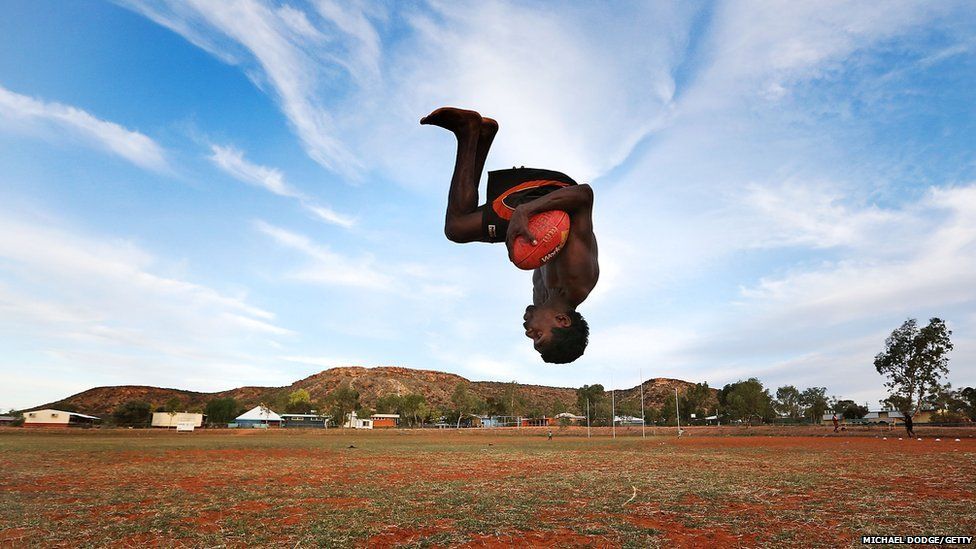Australia's new state? Things you might not know about the Northern Territory
- Published

Best known for crocodiles, camels and colourful characters, Australia's Northern Territory (NT) could become the country's seventh state as early as July 2018.
There are various hurdles to jump before that happens but the change would mean more senators from the NT in Federal Parliament, a new name and likely a redesign of the national flag.
Here are some things you might not know about Australia's outback territory.
Where is the NT and who lives there?
A mix of Indigenous, British and Asian influences set against a backdrop of stunning, wild scenery has created what is possibly Australia's most unique region.
Closer to Bali than to Bondi, the NT spans about 1.35 million sq km (838,000 sq miles), more than six times the size of the UK.
It is in the central north of the country, between the states of Western Australia and Queensland.
It has two starkly different climates: tropical in the north with a wet and dry season, but in the south the desert centre sees very little rain.
With about 240,000 people it is the least populated of Australia's self-governing mainland states and territories.
Indigenous Australians have lived in the NT for more than 60,000 years and today represent about 30% of the population, according to the Territory government.
Development came late in Australia's modern history with the port of Darwin established in 1869. At one point, the Chinese population outnumbered Europeans.
Statehood
- There are no specific criteria for how an Australian territory becomes a state but the conversion must be approved by Parliament. Traditionally, territories have had smaller populations than states
- Australia has 10 territories, the two major ones being the NT and the Australian Capital Territory, home to Canberra
- The main difference between a territory and a state is that a territory has less legal independence
- People have been proposing new states since the 19th century, including an Aboriginal state and, while both countries were still British colonies, New Zealand
- No new state has been created since Australia's federation in 1901
A land of spirit and songlines
Indigenous Australians have traditionally believed in what has been described as songlines, or dreaming tracks, that mark the routes followed by spirit beings.
Today, the NT is home to some of Australia's most acclaimed singers and musicians, including Geoffrey Gurrumul Yunupingu, pop export Jessica Mauboy and the ground breaking Yothu Yindi who combined traditional Aboriginal music with modern western instrumentation.
Killer wildlife
The old adage "never smile at a crocodile" couldn't be more appropriate for Territorians and visitors.
Most rivers in the region have, on average, five crocodiles per kilometre so it's not surprising authorities this year urged tourists not to take selfies near the world's deadliest predators.
Invasive species pose a danger of a different sort. Feral animals such as camels, cane toads, cats and pigs, among many others, do untold damage to NT flora and fauna.
In 1860s, Afghan cameleers brought their "ships of the desert" to the Australian outback. More than a century later, feral camel populations peaked at about one million.
By 2013, populations were nearly halved in a controversial cull. Even so, it is estimated that camels still roam across about 40% of the Territory.
A deadly cane toad has also caused chaos after it was introduced from South America in 1935 in a bid to kill a native beetle that was damaging sugar cane crops.
With no local predators, cane toad numbers have grown rapidly, spreading to Western Australia and down the east coast, in recent years. Venom secreted by glands in their back can quickly kill native animals that try to feed on them.
Australia's Pearl Harbor
In a little known chapter in Australia's military history, Australia came under foreign attack for the first time, in World War Two, when Japanese forces launched air raids on the city of Darwin and other targets in the Territory.
In the largest Japanese attack after Pearl Harbor, 188 Japanese planes were launched against the northern capital and its harbour full of Allied ships.
Up to 1,100 people were killed in the surprise attack.
Nature's Fury: Cyclone Tracy
Darwin was also the site of one of Australia's worst natural disasters, devastated on Christmas Eve 1974 by Cyclone Tracy.
Tracy killed 71 people and destroyed more than 70% of Darwin's buildings, including 80% of all homes.
Most of the population was evacuated to other Australian cities and many residents never returned to Darwin.
'A dingo took my baby'
The NT has its share of crime and is home to two of Australia's biggest mysteries: the death of baby Azaria Chamberlain in 1980, and the disappearance of English tourist Peter Falconio in 2001.
Australians Lindy and Michael Chamberlain were camping at Uluru when their baby girl Azaria disappeared from the family's tent.
Her body was never found but her parents told police a dingo took the child.
In 1982, Lindy was found guilty of murdering Azaria and her husband was found guilty of being an accessory after the fact.
In what became one of Australia's most sensational court cases, much of the police evidence was controversial and the nation was divided over the couple's guilt.
Lindy was released in 1986 after new evidence came to light and finally, in 2012, a coroner ruled Azaria had been taken by a dingo.
The real life Wolf Creek
Backpacker Peter Falconio's body was never found either but his girlfriend Joanne Lees said the couple were attacked by Bradley John Murdoch - mechanic and admitted drug runner.
He had flagged down their campervan while they were travelling on an outback highway in the dead of night, a court later heard.
Lees escaped, later telling police she heard Murdoch shoot her boyfriend. Murdoch was arrested following one of Australia's largest manhunts, and eventually found guilty of Falconio's murder.
- Published26 August 2015
- Published24 August 2015
- Published4 August 2015